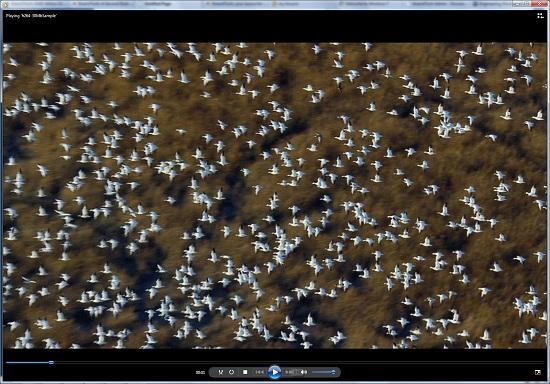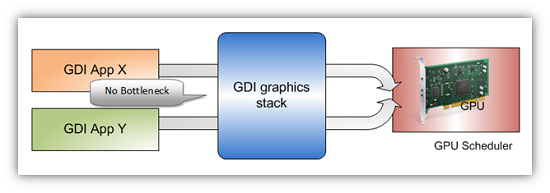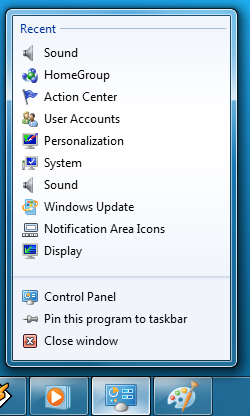Windows 7 Performance Guide
by Ryan Smith and Gary Key on October 26, 2009 12:00 AM EST- Posted in
- Systems
Feature Recap
As we have already covered the bulk of Windows 7’s new features in our look at the Windows 7 Release Candidate, we’re not going to spend too much time here. If you want an in-depth look at the new features, please see that article.
Performance
Vista’s performance was something of a quagmire. Even after SP1 fixed its biggest issues, it continued to be rather RAM hungry and poorly suited for low-end computers and newly minted cheap computers with the performance of older low-end computers. Netbooks made this situation particularly problematic for Microsoft, as their limited performance amplified this issue and resulted in netbooks shipping with Windows XP almost exclusively.
For Windows 7, Windows has been put on a diet in order to perform better on those machines. The most noticeable changes here are that Windows 7 eats less RAM and hard drive space out of the box than a comparable version of Vista did. There have also been some underlying tweaks to SuperFetch (it’s less aggressive on startup) and the kernel to improve responsiveness.
Our own experience here is that Microsoft has come through on this, although whether it’s enough is going to depend on just what someone is looking for. We have a few laptops where Vista was an absolute slug while Win7 runs just as well as Windows normally does. For someone looking for Win7 to perfectly replicate XP’s performance however, they’re going to come away disappointed – you’re never going to stuff something like Windows 7 in to the performance characteristics of an 8 year-old OS that forgoes real security and predates wireless networking.
Also while these changes should percolate to higher-end computers, the impact will be marginal at best. Vista had enough going on that it could bog-down low-end hardware, but hardware that as already capable of running Vista well isn’t going to greatly benefit from changes made to squeeze more out of the low-end. We’ll see this in detail later with our benchmarks.
Media
Windows’ media capabilities have been greatly augmented with Windows 7, primarily through the inclusion of decode and encode capabilities for a number of video and audio formats. While Vista included support for MPEG-2/1 and WMV9 video, Win7 has added support for much more contemporary codecs: H.264 and MPEG-4 (A)SP. Audio support has seen the inclusion of support for AAC and AAC+ audio, commonly found as companion audio streams for H.264 video, streaming internet radio, and portable media players.

Windows Media Player playing a 30Mb H.264 clip entirely in software without breaking a sweat
This gives Windows 7 the ability to play just about everything entirely out of the box, forging the need to deal with codec hell. The only notable things missing here are support for BluRay playback (you’ll need separate software), and some media container types (OGG, Matroska, MOV).
Encode support has been added for H.264 video and AAC audio through the Media Foundation Transcode class. This gives Win7 the ability to encode video on the fly for loading media on to portable media players and streaming to other devices (e.g. DLNA). However the use of this feature is quite limited at this time; only a handful of media players support the level of integration with Windows required to use the encoder. iPods need not apply.
Meanwhile Windows Media Center has seen its own improvements on top of the benefits it derives from greater codec support. At a high level this is a general UI touchup. At a low level this includes adding support for ClearQAM cable tuners, and the user-installation of CableCARD tuners.
Graphics
Windows 7 also brings about some additions to graphics capabilities. The headliner here is DirectX 11, whose introduction is being timed with the launch of Windows 7. DX11 is being released on Vista too any day now, so this is by no means an exclusive feature, but given the timing, it’s one of importance. We’ve already seen AMD launching their 5700 series and 5800 series ahead of Windows 7, so that they can have DX11-supporting cards on the shelves for this launch.
Windows 7-specific changes include the addition of WDDM 1.1, which is a minor update to the video driver stack for better memory utilization. This is accomplished by keeping the texture for a window (when using Aero for desktop composition) solely in VRAM instead of keeping a copy in local system memory too. WDDM 1.1 also brings support for heterogeneous display adapters, something Vista took away.
The GDI graphics stack has also been tweaked for performance reasons. Previously only a single application could write to it at once, making GDI writes a bottleneck. The stack has been changed so that now it’s the responsibility of the GPU to schedule multiple writes, rather than having an application blocked. We haven’t been able to find any performance cases where this is of help, however.

Images courtesy Microsoft
Low-Level
While Windows 7 is not the sizable overhaul of Windows that Vista was, it still has a few low-level changes. The biggest change for users is the official support for the TRIM command for SSDs, which will improve SSD write performance without the need for manual refreshes. The kernel’s dispatcher lock has also been rebuilt for better scaling; previously it effective topped out at 32 cores, now it scales to 256 cores. This will be more felt on the server branch, Windows Server 2008 R2.
Windows XP Mode
Primarily targeted at business users, Microsoft has officially added a derivative of their VirtualPC virtualization technology to Windows 7 in the form of Windows XP Mode. Windows XP Mode is a pre-configured Windows XP Pro virtual machine for running applications that just won’t run natively under Win7, allowing businesses to half-step to Windows 7 as part of a longer transition. It comes as a separate download available for Win7 Professional and higher editions, and no, it doesn’t run games.
Interface
The bulk of the changes in Windows 7 are going to be things that you can see, literally. Various interface elements have received drastic overhauls, and at the risk of slighting all of the other groups at Microsoft, more work appears to have been put in here than anywhere else.
Chief among these is the near-total replacement of the taskbar. The new Win7 taskbar is much closer to Mac OS X’s dock in appearance and function. Active applications appear on the taskbar as just large(r) versions of their application icon, and icons can be pinned in place so that they can be launched from the taskbar in the future, not unlike the old Quick Links feature. Undoubtedly, this is going to be the hardest thing for new users to get used to, although it’s certainly not hard to grow accustomed to.

The Control Panel Jump List
Along-side the dock taskbar are jump lists, which are replacing the normal right-click menu for items in the taskbar. Jump lists contain application specific commands, standard window manipulation commands, and recently used files for the application in question. Applications need to be coded to make full use of jump lists.
Also added are a pair of new Aero gestures. Aero Snap causes an application to be maximized when it’s dragged to the very edge of a screen, and returned to normal when dragged away. Aero Shake minimizes all other windows when a window has been shaken. Microsoft’s Rolodex-wannabe Flip3D is still here, much to our chagrin.
Other notable changes include gadgets, which have been liberated from the sidebar in order to reside on the desktop, and the classic Start Menu, which has been terminated entirely in favor of the Vista (and later) Start Menu. Finally, the whole default color scheme of Windows has been redone; pea green is out, blue/grey is in.
UAC
Finally, User Account Control, the fundamental underpinningsof Vista’s enhanced security, has also seen an overhaul. By reducing the integrity of UAC slightly so that by default it auto-elevates signed Microsoft programs, Microsoft hopes to reduce the perceived annoyance of UAC without compromising the actual security. As a result, UAC should be less noticeable, particularly when first setting up a computer. However there are possible security consequences of this, which we’ll get in to later











207 Comments
View All Comments
yyrkoon - Thursday, October 29, 2009 - link
If I sell you a car, and you crash into something because you had no experience driving; Does that make the car unsafe ? No. It means you the operator should have learned how to operate a vehicle before driving. Now, no, I do not think a computer user should be licensed to operate their own computers; But I *do* think it is their responsibility to learn how to operate one the way they intend it to be used. Does that make one operating system or another insecure ? No.Vista since beta has touted a sand boxed browser; That is even before anyone else implemented it into their browsers. Microsoft does things the way they do because they understand that the average user does not want to spend hours/days/months learning how to use a computer( when perhaps they should).
Torment - Thursday, October 29, 2009 - link
Worst. Analogy. Ever.
If you design a car, and it catches fire because you located the gas tank next to the engine, that makes it unsafe. Sure, the buyer could relocate the gas tank themselves, but that doesn't change the fact that *your* design was unsafe. Further, if the car flips over routinely during normal use, it doesn't matter that you could take more precautions when you take corners. The design has still failed.
The browser is not even remotely sandboxed in Vista or 7. Microsoft *did* decide to sandbox silverlight (both in the browser and standalone), and I think they will do the same with the browser in the next iteration of windows. UAC helps a bit, but with the browser becoming as an application platform, sandboxing is a necessity.
There is a reason why security freaks run VMs for browsing.
yyrkoon - Thursday, October 29, 2009 - link
It is not the worst analogy. Ever.You are intentionally blowing things out of proportion to make things sound worse than they really are. If you change how or when a service runs, this is nothing like relocating a gas tank. That would be like removing the service, and replacing it with another.
That, and, you really know what *smart* security freaks do ? They do things like make a USB bootable copy of their OS, so they can scan their OS drive while unmounted. Or, they run ridiculously impossible to setup setups like SELinux. The latter here is probably less smart, and just more geeky.
Security experts use VMs as honey pots, not for browsing . . .
Gunnman - Tuesday, October 27, 2009 - link
As I read through this I can just imagine some of you holding your O/S boxes. Stroking them lovingly as you hug them in your arms.It all comes down to $$$ I think. If you have a piece of crap machine and have no cash or are one of those historian fanboys refusing to get rid of that TRS80, then sure keep DOS as the best os ever!! :P
If all you do is surf and use productivity apps, no need to upgrade from XP, I can see that.
If your needing a new upgrade and the new O/S's will not run on your rig. OK Stay on XP.
But you can not blame others that have good jobs and enjoy the life of the Enthusiast getting bleeding edge hardware and moving to the newest O/S.
I enjoy this very thing, it's fun getting the latest tech (in intervals). And nothing is more enjoyable (as far as computers)than installing that latest O/S and learning all about it's operation and putting it through its paces.
I like XP for what it is but I like Vista and 7's interface much better (it's pretty). :P
I do have a quad-boot on my system Win7 (primary O/S) then Vista then XP and then Linux, just in case I need them. You never can tell in the x86 world.
I'm prepped for anything.
Win 7 having added features of DX11 Direct Compute I think thats cool to do away with proprietary physics. I hope Nvidia didnt pay too much for Ageia.
I do more than game but I like to do it all in style. :)
MonicaS - Tuesday, October 27, 2009 - link
I have never seen such a lackluster launch for something this big. Even mediocre cellphones we'll never us from companies we've never heard from have greater PR and fanfare to their releases. Still, W7 is great so far!Monica S
Los Angeles Computer Repair
http://www.sebecomputercare.com">http://www.sebecomputercare.com
7oby - Tuesday, October 27, 2009 - link
If the evaluation of an OS depends on criteria such as application integration and homogeneity, user habits and visual appeal, then don't miss to check out KDE 4.3 as integrated in Kubuntu 9.10.Although KDE 4.3 still isn't as mature as Gnome is, to the novice user it feels and looks better.
ProDigit - Tuesday, October 27, 2009 - link
The graphs of Anandtech differ too much with my own experiences!In many cases I think they made up the graphs by random or choice, rather than by actual testing.
I tested Win7 RC1 on my laptop, and it performs similar to XP, but not as snappy. It also runs hotter, and battery life suffered compared to XP.
Under Vista SP1 my laptop suffered A LOT on the battery life!!!
Win XP: 5,5Hours
Win 7: ~5hours
Vista: ~4,3 hours
In the tests done above it almost seems like Vista uses less battery than XP, which is just plain stupid and idiotic to claim that!
My experiences differ much, and like before I do believe that Anandtech is a tech site with biased reviews and opinions.
For this it is worse than Tomshardware, in that tomshardware can be biased, but it's articles always go together with the reality.
My experience is that anandtech pushes Nvidia and Intel,and now Win7.
Even from the time when AMD was clearly a better purchase in both graphics cards and processors, they still focused on Intel; and on multiple occasions twist graphs to their benefit!
This is a serious accusation, not my opinion alone anymore, but of many, and it has come to a point where it became too obvious...
Even with their article about "Internet Explorer 8 uses less power than Firefox"-article,
Well I've researched, and found that Internet Explorer 8 running a flash game had a lower FPS than Firefox.
I even took it further, on a T5500 CPU with XP, 2Gig RAM and Firefox, I had an average of 15fps.
Same game, Vista SP1, T7500 with 4Gig Ram, and IE8, I had an average of 4fps!!!
No wonder they are using lower power.
But that aside, which was probably the last article I could not get shoved through my throat, I think I've seen enough of Anandtech, and would recommend all users to read less biased reviews on tomshardware.com!!!
You'll notice immediately that they both offer different perspectives, and in my experience tomshardware has always been closer to the reality than Anandtech!
Flyboy27 - Tuesday, October 27, 2009 - link
Tom's Hardware was once a great place especially back in the Thomas Pabst days. However, lately there is no reason to go there since they fired Ben, Travis, and Rob. For fuck's sake Tom's Games is now all flash games, WTF (I think there are a lot of people that are sore about this). I don't know where to go to get good game reviews anymore. If someone has any suggestions please let me know. Tom's got rid of their most unique content and is now little more than a cheap imitation of its former self, it's really sad actually. I hope Anand doesn't sell out to some shitty corporation. I wish I would have known about Anandtech back in the 90's. Its just too bad that they really don't cover games that well since there are so many SHIIIIITY review sites out there.goinginstyle - Tuesday, October 27, 2009 - link
You have to be joking right? While Toms has improved recently, their analysis is far from competing with AT and they tend to be overly biased in several areas. Did you read Tom's Win7 article? It basically said XP users now have a reason to upgrade but they did not run any tests on XP. Tell me, how is that being closer to reality?It is funny to see all of these comments saying the Tom's Win7 article was better and it basically was nothing more than a PCWorld article. Apparently you have not read the latest AMD reviews here, they are all positive, fair, and recommend their products.
Peroxyde - Tuesday, October 27, 2009 - link
Last paragraph in the article, section "7 vs Linux": "Win7 erodes the Linux advantage against Windows in the performance cases where Vista suffered".In all the benchmarks shown in the article, Vista almost has the same score than Windows 7. Why would Vista suffers some performance loss against Linux and Win7 does not? Can you please clarify?